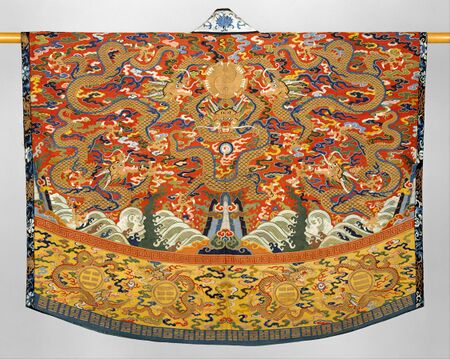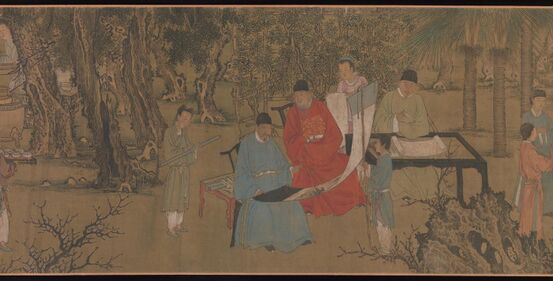Religion:Taoist art
Taoist Art relates to the Taoist philosophy and narratives of Lao-tzu that promote "living simply and honestly and in harmony with nature."[1]
The artists were "Daoist masters, adepts, scholars-amateurs, and even emperors..." thus an eclectic group of art works were created over time that are as varied as their makers .[2]
| Robe embroidered with 5 dragons hovering over a landscape of mountains and ocean, likely worn by a Taoist priest during ceremonies. |
Concept
The philosophy of Taoism traces back to the late Bronze Age (third - fifth centuries B.C.), and later developed into a set of religious practices. Currently Taoism is considered a "living religion, practiced in Taiwan, Hong Kong, and many overseas Chinese communities, and one that is undergoing a major revival in mainland Chinas today.” p. 13 [3][4]
An exhibition called Taoism and the Arts of China, presented at The Chicago Institute of Art (2000) emphasized the art of the late Han to Qing dynasties and followed "the transformations of Taoism into an organized religion, the Taoist pantheon of gods who inhabit the stars and the heavens, modes of ritual and visualization, the cult of the immortals, and the role of landscape as a symbol of cosmic structure and process.”[3]
References
- ↑ "Definition of TAOISM" (in en). https://www.merriam-webster.com/dictionary/Taoism.
- ↑ Augustin, Birgitta. “Daoism and Daoist Art.” In Heilbrunn Timeline of Art History. New York: The Metropolitan Museum of Art, 2000–. http://www.metmuseum.org/toah/hd/daoi/hd_daoi.htm (December 2011)
- ↑ 3.0 3.1 1954-, Little, Stephen, (2000). Taoism and the arts of China. Eichman, Shawn. (1st ed.). Chicago: Art Institute of Chicago. ISBN 9780520227842. OCLC 44117921. https://www.worldcat.org/oclc/44117921.
- ↑ "Out Of Print : Taoism and the Arts of China : Stephen Little - University of California Press" (in en). https://www.ucpress.edu/op.php?isbn=9780520227859.




